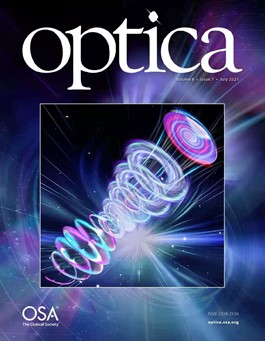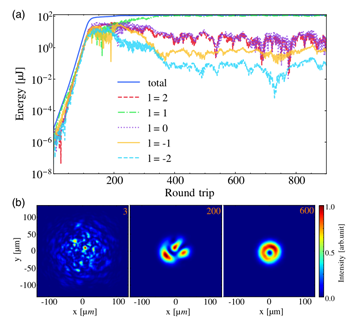







Figure 1. Cover story of Optica: vortex x-ray generation in x-ray FEL oscillator.
Because of its special properties, vortex light in the field of optics is focused on its generation, regulation, and detection. Vortex light has been used in many fields, including data transmission, manipulating the motion of microscopic particles, and precise measurements, etc. The vortex light is usually generated by optical devices such as helical phase plate or holographic grating which are difficultly processed. As a key problem, the generation of vortex X-ray is to be solved urgently. Free electron laser (FEL) based on particle accelerators is an advanced light source, and can produce high brightness, short pulses of X-rays. The combination of vortex light with FEL is expected to provide new opportunities for photon science. At present, generating vortex X-rays with a free electron laser is implement by helical undulators which operate at the higher harmonics of the seed laser.
To solve above problem, the researchers propose generating fully coherent vortex light in an X-ray free electron laser oscillator. Gain detuning is used to control the gain of the high-order transverse mode without optical conversion elements and helical undulators, thus generating vortex light naturally in the traditional X-ray free electron laser oscillator. The simulation results based on the Shanghai high repetition rate XFEL and extreme light facility (SHINE) show that a single vortex X-ray beam with a 100-μJ pulse energy can be generated at 1 MHZ repetition rate. Now, this is the only scheme for generating fully coherent vortex X-ray, and it is of great significance for further expanding the research of X-ray free electron laser oscillator and developing new experimental methods.

Figure 2. Transverse mode evolution in x-ray FEL oscillator.
Since the X-ray free electron laser oscillator was proposed in 2008, the free electron laser team in Shanghai Synchrotron Radiation Facility Center has made many research progresses and continues to promote the relevant development. In 2012, a harmonic operation of X-ray free electron laser oscillator was proposed (Physical Review Letters, 108, 034802) so that the intermedium energy electron beam can drive the X-ray free electron laser oscillator, and the requirement of electron beam energy is greatly reduced in this mode. In 2018, a gain guided mode of X-ray free electron laser oscillator (Applied Physics Letters, 113, 061106) was proposed. In the absence of a additional focusing element, the self-focusing effect of FEL gain can maintain the transverse mode of the X-ray free electron laser oscillator, and the output efficiency and stability are not affected.
This research was supported by the National Natural Science Foundation of China, the National Key Research and Development Program of China, the Chinese Academy of Sciences, and the City of Shanghai.
The article links: https://doi.org/10.1364/OPTICA.428341